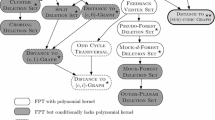Abstract
A feedback vertex set (FVS) of an undirected graph is a set of vertices that contains at least one vertex of each cycle of the graph. The feedback vertex set problem consists of constructing a FVS of size less than a certain given value. This combinatorial optimization problem has many practical applications, but it is in the nondeterministic polynomial-complete class of worst-case computational complexity. In this paper we define a spin glass model for the FVS problem and then study this model on the ensemble of finite-connectivity random graphs. In our model the global cycle constraints are represented through the local constraints on all the edges of the graph, and they are then treated by distributed message-passing procedures such as belief propagation. Our belief propagation-guided decimation algorithm can construct nearly optimal feedback vertex sets for single random graph instances and regular lattices. We also design a spin glass model for the FVS problem on a directed graph. Our work will be very useful for identifying the set of vertices that contribute most significantly to the dynamical complexity of a large networked system.
Similar content being viewed by others
References
S.A. Cook, The complexity of theorem-proving procedures, in Proceedings of the 3rd Annual ACM Symposium on Theory of Computing, edited by P.M. Lewis, M.J. Fischer, J.E. Hopcroft, A.L. Rosenberg, J.W. Thatcher, P.R. Young (New York, ACM, 1971), pp. 151–158
R.M. Karp, Reducibility among combinatorial problems, in Complexity of Computer Computations, edited by E. Miller, J.W. Thatcher, J.D. Bohlinger (New York Plenum Press, 1972), pp. 85–103
M. Garey, D.S. Johnson, Computers and Intractability: A Guide to the Theory of NP-Completeness (Freeman, San Francisco, 1979)
L.W. Beineke, R.C. Vandell, J. Graph Theory 25, 59 (1997)
D. Zöbel, SIGOPS Oper. Syst. Rev. 17, 6 (1983)
B. Fiedler, A. Mochizuki, G. Kurosawa, D. Saito, J. Dyn. Diff. Eq. 25, 563 (2013)
A. Mochizuki, B. Fiedler, G. Kurosawa, D. Saito, J. Theor. Biol. 335, 130 (2013)
Y.-Y. Liu, J.-J. Slotine, A.-L. Barabási, Nature 473, 167 (2011)
Y.-Y. Liu, J.-J. Slotine, A.-L. Barabási, Proc. Natl. Acad. Sci. USA 110, 2460 (2013)
G. Bianconi, M. Marsili, J. Stat. Mech.: Theor. Exp. 2005, P06005 (2005)
E. Marinari, R. Monasson, G. Semerjian, Europhys. Lett. 73, 8 (2006)
E. Marinari, G. Semerjian, J. Stat. Mech.: Theor. Exp. 2006, P06019 (2006)
E. Marinari, G. Semerjian, V. Van Kerrebroeck, Phys. Rev. E 75, 066708 (2007)
G. Bianconi, N. Gulbahce, J. Phys. A 41, 224003 (2008)
Da-Ren He, Zong-Hua Liu, Bing-Hong Wang, Complex Systems and Complex Network (Higher Education Press, Beijing, 2009)
M. Bayati, C. Borgs, A. Braunstein, J. Chayes, Phys. Rev. Lett. 101, 037208 (2008)
M. Bailly-Bechet, C. Borgs, A. Braunstein, J. Cheyes, A. Dagkessamanskaia, J.-M. Francois, R. Zecchina, Proc. Natl. Acad. Sci. USA 108, 882 (2011)
I. Biazzo, A. Braunstein, R. Zecchina, Phys. Rev. E 86, 026706 (2012)
H.A. Bethe, Proc. R. Soc. London A 150, 552 (1935)
R. Peierls, Proc. R. Soc. London A 154, 207 (1936)
R. Peierls, Proc. Camb. Phil. Soc. 32, 477 (1936)
M. Mézard, A. Montanari, Information, Physics, and Computation (Oxford Univ. Press, New York, 2009)
H.-J. Zhou, C. Wang, J. Stat. Phys. 148, 513 (2012)
J.-Q. Xiao, H.-J. Zhou, J. Phys. A 44, 425001 (2011)
H.-J. Zhou, C. Wang, J.-Q. Xiao, Z. Bi, J. Stat. Mech.: Theo. Exp. 2011, L12001 (2011)
R. Kikuchi, Phys. Rev. 81, 988 (1951)
G. An, J. Stat. Phys. 52, 727 (1988)
M. Mézard, G. Parisi, Eur. Phys. J. B 20, 217 (2001)
S. Bau, N.C. Wormald, S.-M. Zhou, Random Struct. Alg. 21, 397 (2002)
V. Bafna, P. Berman, T. Fujito, SIAM J. Discrete Math. 12, 289 (1999)
A. Lucas, arXiv:1302.5841 (2013)
Author information
Authors and Affiliations
Corresponding author
Rights and permissions
About this article
Cite this article
Zhou, HJ. Spin glass approach to the feedback vertex set problem. Eur. Phys. J. B 86, 455 (2013). https://doi.org/10.1140/epjb/e2013-40690-1
Received:
Revised:
Published:
DOI: https://doi.org/10.1140/epjb/e2013-40690-1




